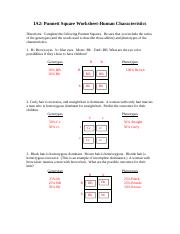Ever wondered why you have your mom’s eyes and your dad’s smile? Or why your sibling might have a completely different hair color? The secrets lie within the fascinating world of genetics, and Punnett squares are the key to unlocking these hereditary mysteries. By exploring Punnett squares, we’re not just analyzing patterns of inheritance, but delving into the very blueprints of life, understanding how traits are passed down through generations.

Image: answerlibrarymccullough.z19.web.core.windows.net
A Punnett square is a visual tool used in genetics to predict the possible genotypes and phenotypes of offspring resulting from a cross between two individuals. It works by organizing the possible allele combinations from each parent, revealing the probability of each genotype in the offspring. The beauty of this simple diagram lies in its ability to explain complex biological processes, making genetics accessible even to those with little scientific background.
Understanding the Basics of Genetics
Before diving into the intricacies of Punnett squares, let’s first grasp the fundamental principles of genetics. Every individual carries a set of instructions for their physical traits, known as their genotype. These instructions are encoded in genes located on chromosomes, which are thread-like structures found in the nucleus of every cell.
Genes and Alleles: The Building Blocks of Inheritance
Within each gene, there can be different versions, called alleles. Alleles are responsible for the variations we see in traits, such as eye color, hair texture, and even certain disease predispositions. Humans inherit one allele from each parent, forming a pair. The combination of these two alleles determines the individual’s phenotype, which are their observable characteristics.
Dominant and Recessive Alleles: A Tale of Two
Alleles don’t always have the same influence. Some alleles are dominant, meaning they’ll express their trait even if only one copy is present. Other alleles are recessive, requiring two copies for their trait to be expressed. For example, to have brown eyes, you need only one copy of the dominant brown eye allele. But to have blue eyes, you need two copies of the recessive blue eye allele.

Image: imgkristi29.blogspot.com
Punnett Square Worksheet: A Step-by-Step Guide
Let’s take a concrete example to understand how Punnett squares work. Imagine we’re following the inheritance of a simple trait like eye color. Let’s say one parent has brown eyes (BB) and the other parent has blue eyes (bb). Here’s how to construct a Punnett square:
- Step 1: Draw a 2×2 grid.
- Step 2: Label the top row of the grid with the alleles from one parent (in this case, B and B).
- Step 3: Label the left column of the grid with the alleles from the other parent (in this case, b and b).
- Step 4: Inside each cell of the grid, write the combination of alleles from the corresponding row and column.
The Punnett Square for Eye Color: A Visual Representation
Here’s how the Punnett square looks for our example:
| B | B | |
|---|---|---|
| b | Bb | Bb |
| b | Bb | Bb |
Each cell represents a possible genotype for the offspring. In this case, all four offspring will have the genotype Bb, which represents brown eyes.
Applying Punnett Squares to More Complex Traits
While the eye color example demonstrates a simple inheritance pattern, many traits are controlled by multiple genes interacting with each other. This makes the outcomes in the Punnett square more diverse and complex. For example, height is influenced by numerous genes, resulting in a wider range of possible heights in offspring.
Beyond the Classroom: The Real-World Applications of Punnett Squares
Punnett squares are not just theoretical tools for classroom exercises. They have significant implications in:
1. Medical Genetics: Understanding and Predicting Disease Risk
Punnett squares can be used to assess the risk of inheriting genetic disorders. By understanding the inheritance patterns of specific diseases, medical professionals can provide personalized counseling and genetic testing options.
2. Animal and Plant Breeding: Optimizing Desired Traits
Farmers and breeders use Punnett squares to predict the outcomes of crosses, allowing them to select for desired traits like increased milk production in cows or disease resistance in crops. This helps produce healthier and more productive livestock and plants.
3. Forensic Science: Tracing Lineage and Identifying Individuals
Punnett square principles are applied in DNA profiling to establish paternity, identify individuals in forensic investigations, and trace familial relationships.
The Future of Genetics: Exploring New Horizons
The field of genetics is constantly evolving, with advancements in gene editing technologies and personalized medicine. As our understanding of human genetics deepens, Punnett squares will continue to play a crucial role in explaining and predicting various biological processes, ultimately contributing to a healthier and more informed future.
Punnett Square Worksheet Human Characteristics Answers
https://youtube.com/watch?v=mS7apZh810s
Conclusion: Unlocking the Secrets of Life
Punnett squares are invaluable tools that provide a window into the fascinating world of inheritance. They allow us to predict the probabilities of offspring genotypes and phenotypes, unraveling the mysteries of why we inherit certain traits from our parents. From predicting disease risk to optimizing animal and plant breeding, the applications of Punnett squares are wide-reaching and essential for a deeper understanding of the human condition. So next time you look in the mirror, remember the powerful forces of genetics at play, shaping your unique features and the story of your life.






